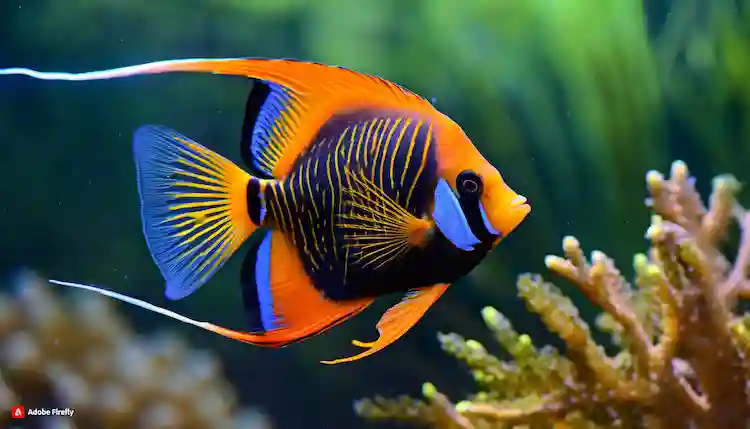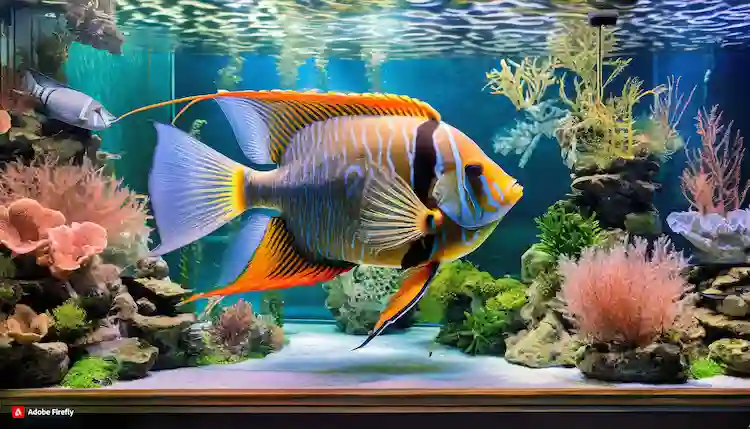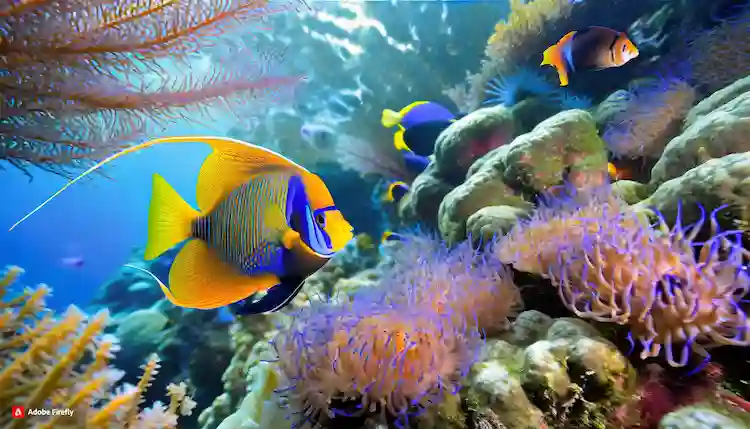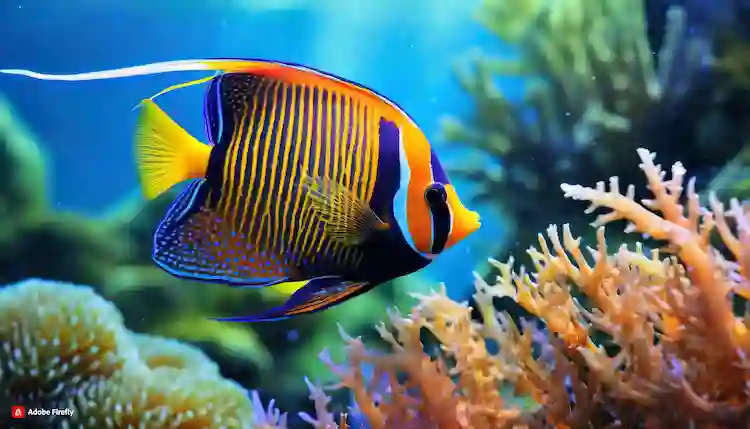Regal Angelfish Care Guide: Creating a Stunning Marine Aquarium
Updated: October 18, 2023
139
Introduction
Regal Angelfish scientifically known as Pygoplites diacanthus, is a popular marine angelfish species in the aquarium hobby. Its vibrant coloration and distinctive features make it a sought-after specimen for saltwater enthusiasts.

Overview
This fish, also referred to as royal angelfish or royal empress angelfish, is native to the Indo-Pacific region, particularly the Red Sea and the Coral Sea. It is commonly found in reefs, where it seeks shelter among live rocks and caves.
Appearance
This fish is a relatively large angelfish, with an adult size of up to 10 inches. It has an elongated body with a graceful shape and a prominent, flowing dorsal fin. The colouration of this angelfish is striking, with a bright yellow body adorned with vertical white bars and a vibrant blue caudal fin.
Distinctive Features
One of the distinctive features of this fish is its protruding mouth, which is adapted for grazing on coral polyps and tunicates. It also has an anal fin that extends into a long, filament-like streamer, adding to its unique appearance.
Habitat
As mentioned earlier, they are commonly found in reefs, particularly in the Red Sea and the Coral Sea. In their natural environment, they inhabit areas with both hard and soft corals, as well as plenty of hiding places and caves to provide shelter.
Natural Environment
This fish is often seen grazing on coral polyps and tunicates in its natural environment. It has a particular affinity for LPS (large polyp stony) corals, which provide a nutritious food source.
Reef Compatibility
These angelfish are generally considered reef-safe, but caution should be exercised when keeping them in a reef tank. While they are not known to eat corals, they may nip at soft corals and clam mantles. It is important to provide them with a well-fed diet to minimize the risk of them grazing on corals.
Aquarium Care
When caring for this fish in an aquarium, it is crucial to ensure that the water parameters are stable and within the appropriate range for marine fish. A minimum tank size of 75 gallons is recommended to provide ample swimming space for this active angelfish.
Setting up the Ideal Aquarium
An ideal aquarium setup for these fish should include live rocks with plenty of hiding places and caves. This will allow the angelfish to exhibit natural behaviours and provide them with shelter. A diverse diet consisting of high-quality pellets, frozen foods such as mysis shrimp and brine shrimp, and occasionally live foods, should be provided to meet their nutritional needs.

Feeding and Nutrition
These fish are omnivores and require a varied diet to thrive in captivity. In addition to grazing on corals, they will readily accept prepared foods such as pellets and frozen foods. However, it is important to feed them a balanced diet that includes a mix of plant-based and protein-rich foods to mimic their natural feeding habits.

Behaviour and Temperament
This fish is generally peaceful, but like many angelfish species, it can become territorial and aggressive towards other fish in the aquarium. It is best to keep them as the only angelfish in a tank, or with other peaceful tank mates that can withstand their occasional aggression.
Social Behavior
They are known to be solitary in the wild and may exhibit similar behaviour in captivity. However, with ample space and hiding places, they can coexist peacefully with other compatible species in a well-maintained aquarium.
Compatibility with Other Fish
When considering tank mates for this fish, it is important to choose species that can withstand their occasional aggression. Peaceful fish, such as clownfish and tangs, can make suitable tank mates, but aggression should be monitored closely to ensure the well-being of all inhabitants.
Breeding
Breeding these fish in captivity can be challenging due to their complex reproductive behaviours and specific requirements. As of now, there have been limited successful breeding attempts reported in the aquarium hobby.
Challenges of Breeding
One of the main challenges in breeding this fish is replicating their natural spawning conditions and inducing them to spawn. Additionally, the larval-rearing phase requires specialized equipment and expertise, making it a daunting task for most aquarists.
Successful Breeding Techniques
Despite the challenges, there have been a few successful breeding attempts with this fish in the past. These attempts involved the careful selection of compatible pairs, controlled lighting and temperature conditions, and the provision of appropriate nest sites.

Tips for Keeping These Fish Happy and Healthy
To keep regal angelfish happy and healthy in an aquarium, it is crucial to maintain excellent water quality, provide a well-balanced diet, and ensure sufficient hiding places and swimming space. Regular observation and monitoring of their behaviour and appetite can help detect any signs of stress or illness early on.
Conclusion
In conclusion, regal angelfish, also known as royal angelfish, is a captivating species that adds a touch of beauty to any saltwater aquarium. With proper care and attention, they can thrive in captivity and provide endless enjoyment for dedicated aquarists.
What is a regal angelfish
A regal angelfish, scientifically known as pygoplites diacanthus, is a species of saltwater marine fish
What do regal angelfish eat?
Regal angelfish primarily feeds on mysis shrimp and other meaty foods. They may also graze on algae and clam flesh in the wild.
Can regal angelfish live in a marine aquarium?
Yes, regal angelfish can be kept in a marine aquarium. They are popular choices for saltwater aquarium enthusiasts.
Are regal angelfish reefs safe?
It depends on the individual specimen. While some regal angelfish may be reef-safe, others may nip at corals and other invertebrates
How big does a regal angelfish grow?
Regal angelfish can grow up to 10 inches in length, but most specimens found in marine aquariums are smaller, ranging from 4 to 7 inches.
Where are regal angelfish found in the wild?
Regal angelfish are native to the Red Sea and the Indian Ocean, particularly the Tuamoto Islands and East Africa.
Can regal angelfish be kept in a small aquarium?
It is not recommended to keep regal angelfish in small aquariums. They require a large tank, preferably 100 gallons or more.
Is the regal angelfish an aggressive fish?
The regal angelfish is generally not considered aggressive. However, they may become territorial and aggressive towards other tank mates if not properly acclimated or if the tank is too small.
Are regal angelfish endangered?
According to the IUCN Red List, regal angelfish are not considered endangered. However, they should still be responsibly sourced, preferably captive-bred.
How many regal angelfish can be kept together?
It is generally recommended to keep only one regal angelfish in a tank unless you have a large aquarium where two specimens can establish their territories.
Please Write Your Comments